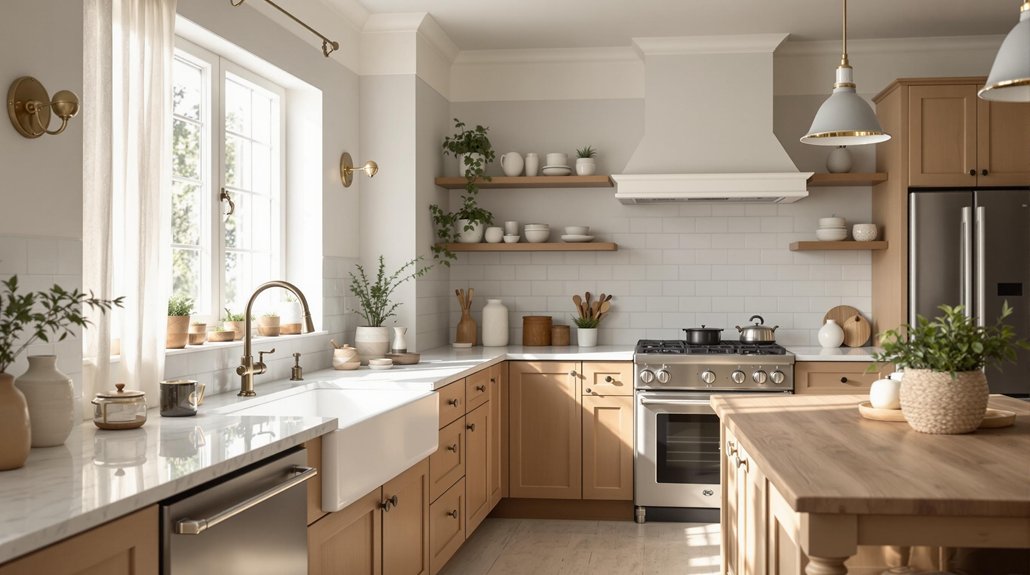
15 Beige and White Kitchen Ideas That Feel Warm and Balanced
A beige and white kitchen uses balanced neutrals, textured finishes, and functional accents for a warm, inviting atmosphere. Beige shaker cabinets with crisp white walls amplify brightness, while brass hardware and off-white backsplashes add depth and refinement. Two-tone islands, marble surfaces, and contrasting black fixtures create visual anchors. Layered natural materials, open shelving, and integrated lighting enhance tactile comfort and utility. Explore innovative layouts, rustic feature walls, and modern integrations to achieve spaces that feel both cozy and sophisticated.
Key Takeaways
- Pair beige shaker cabinets with crisp white walls to create a timeless, light-filled kitchen that feels both warm and spacious.
- Use a two-tone island in soft beige and white as a stylish focal point that adds depth and visual interest.
- Incorporate textured off-white backsplash tiles and beige natural stone countertops for tactile variety and organic warmth.
- Add brass hardware and lighting fixtures to introduce visual contrast and a touch of luxury to the neutral palette.
- Design a cozy breakfast nook with beige cushions, natural wood, and large windows to maximize comfort and natural light.
Beige Shaker Cabinets With Crisp White Walls
A beige shaker cabinet configuration juxtaposed against crisp white walls exemplifies a sophisticated approach to kitchen design, balancing warmth with spatial clarity.
The subtle warmth of beige shaker cabinets introduces an inviting tactile quality, enhancing the kitchen’s overall sense of comfort. When paired with crisp white walls, the cabinetry’s warm appeal is accentuated, while the pristine backdrop maximizes natural light and amplifies a sense of openness.
Beige shaker cabinets and crisp white walls create an inviting ambiance, blending warmth and brightness for a comfortable, open kitchen atmosphere.
This interplay between cabinetry and wall color achieves timeless versatility, adapting seamlessly to both traditional and modern aesthetics. The reflective properties of white surfaces further optimize functional brightness, making the space appear larger.
Collectively, the beige and white palette establishes a harmonious equilibrium, elevating the kitchen’s visual interest while ensuring enduring style and practical functionality for contemporary living.
Two-Tone Island in Soft Beige and White
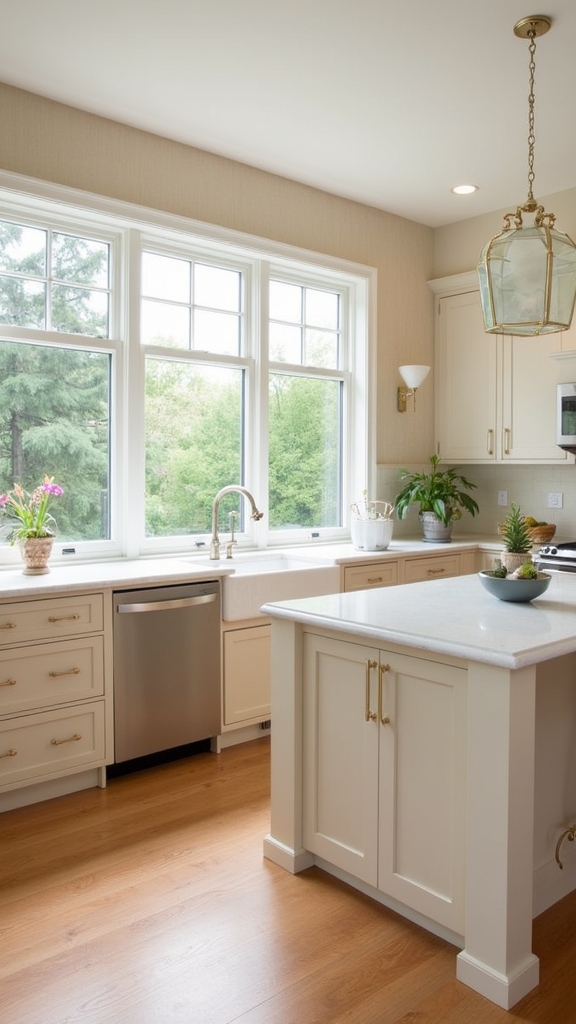
A two-tone island rendered in soft beige and white introduces a distinct focal point that strategically anchors the kitchen’s compositional flow.
This configuration leverages the visual warmth of soft beige cabinetry against the crisp neutrality of white, yielding a layered aesthetic that enhances spatial depth and sophistication.
The juxtaposition of the two hues establishes a balanced palette, cultivating an inviting kitchen ambience that gracefully bridges modern minimalism and timeless comfort.
Functionally, the two-tone island serves as both a culinary workspace and a social hub, its warm tones encouraging gathering while maintaining a sleek, uncluttered profile.
Integrating natural materials—such as a beige stone countertop—further boosts tactile appeal, reinforcing the harmonious dialogue between warmth and brightness that defines a well-composed, inviting kitchen environment.
Warm Brass Accents in a Neutral Palette
Warm brass accents introduce a layer of visual richness to beige and white kitchens, elevating the neutral palette with refined sophistication.
Coordinated brass hardware and fixtures establish continuity, enhancing the inherent warmth of beige cabinetry while providing dimensional contrast against crisp white surfaces.
This strategic integration of warm metallics achieves a harmonious balance, resulting in a space that is both welcoming and visually engaging.
Gold hardware remains a popular choice in kitchen design, with minimalist aesthetics expected to dominate trends.
Enhancing Beige With Brass
Several polished brass accents strategically placed within a beige and white kitchen introduce a layer of visual richness and tactile contrast to the neutral palette. The interplay between brass accents and beige cabinetry establishes a sophisticated dialogue of warm tones, fostering visual interest that is both subtle and impactful. By utilizing the inherent luminosity of brass, designers can prevent beige surfaces from appearing monochromatic or muted.
| Application | Design Impact |
|---|---|
| Brass lighting | Amplifies warmth, enhances focal points |
| Faucet/fixtures | Instills luxury, defines work zones |
| Decorative objects | Adds detail, breaks up uniform surfaces |
This expert approach guarantees the kitchen remains harmonious while achieving multidimensional depth. Brass elements, when paired with natural materials like stone and wood, seamlessly integrate into both modern and traditional schemes, elevating the overall ambiance with timeless elegance.
Coordinating Hardware and Fixtures
Brass hardware and fixtures serve as precise visual anchors within beige and white kitchens, imparting a refined metallic warmth that enlivens the surrounding neutrals.
When integrated thoughtfully, brass accents—such as cabinet pulls and plumbing fixtures—offer a strategic counterpoint to beige cabinetry, preventing tonal monotony and reinforcing a cohesive look. Their lustrous surfaces reflect light, enhancing spatial brightness while introducing sophisticated visual interest.
In kitchen design, the pairing of warm brass with both modern and traditional cabinetry underscores versatility, blending seamlessly into varied aesthetic contexts. The juxtaposition of shiny brass with creamy whites creates layered depth, fostering a harmonious balance.
Functionally, these metallic components raise the tactile experience, simultaneously signaling luxury and durability, essential for enduring and visually compelling kitchen environments.
Balancing Warm Metallics
Metallic interplay emerges as a defining element in the nuanced balance of beige and white kitchens, where the integration of warm brass accents achieves both visual depth and tactile interest.
In this context, brass hardware, fixtures, and accessories introduce a sophisticated sheen that enhances the neutral palette without overpowering it. The reflective qualities of warm brass accents against beige cabinetry generate subtle contrast, ensuring the kitchen remains visually dynamic rather than flat.
Strategically positioned brass elements—such as handles, faucets, and lighting—highlight architectural features and create focal points. This harmonious synthesis of metallic warmth and neutral tones results in a cozy space that feels both inviting and refined.
Ultimately, the interplay of brass and beige underpins a timeless yet contemporary kitchen aesthetic.
Off-White Backsplash With Beige Countertops
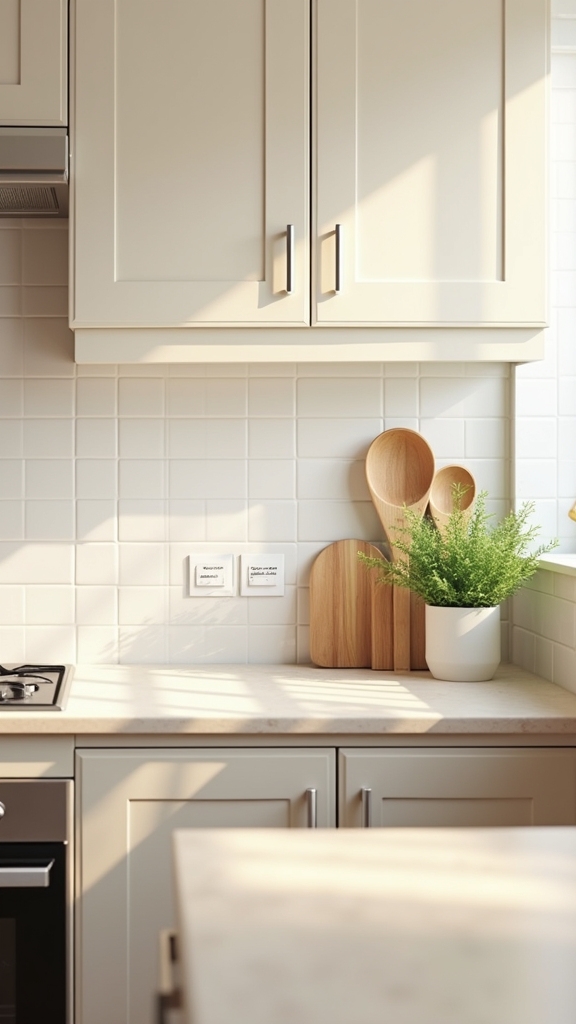
An off-white backsplash paired with beige countertops establishes a nuanced neutral palette that exudes both warmth and visual clarity.
The interplay of glossy or matte tile finishes introduces tactile variation, strategically enhancing depth without overwhelming the design.
This harmonious combination functions as a versatile foundation, supporting both minimalist and layered decorative schemes.
Harmonizing Neutral Color Palette
When executed with precision, the pairing of an off-white backsplash and beige countertops establishes a cohesive neutral color palette that serves both aesthetic and functional purposes. This combination leverages the warm undertones of beige countertops, subtly contrasted by the cool, crisp appeal of an off-white backsplash. The result is a visually balanced environment that feels inviting yet sophisticated, while maximizing spatial luminosity—particularly beneficial for compact kitchens. The neutral color palette not only highlights natural textures and architectural lines, but also accommodates a wide range of decor styles, enhancing design flexibility and longevity.
| Element | Visual Effect | Functional Benefit |
|---|---|---|
| Off-White Backsplash | Brightens space | Easy to coordinate |
| Beige Countertops | Adds warmth | Hides minor stains |
| Neutral Color Palette | Enhances cohesion | Timeless versatility |
Enhancing Depth With Texture
Integrating textured off-white backsplash tiles with beige countertops introduces dimensionality to the kitchen, enriching the neutral palette through both visual and tactile contrast. The interplay between the off-white backsplash and beige countertops offers a sophisticated foundation while utilizing texture to amplify warmth and depth.
Strategic material selection enhances the kitchen’s atmosphere and functional longevity:
- Textured off-white backsplash tiles create a dynamic surface, increasing tactile interest and inviting closer inspection.
- Beige countertops in natural stone provide organic warmth, anchoring the design with enduring elegance.
- Glossy finishes on off-white tiles reflect ambient light, maximizing brightness without compromising the cozy quality of the space.
- This layered, neutral scheme offers flexibility to incorporate accent colors or decor, ensuring adaptability without visual overload.
Texture remains central to both the sensory and aesthetic experience.
Scandinavian-Inspired Minimalist Design
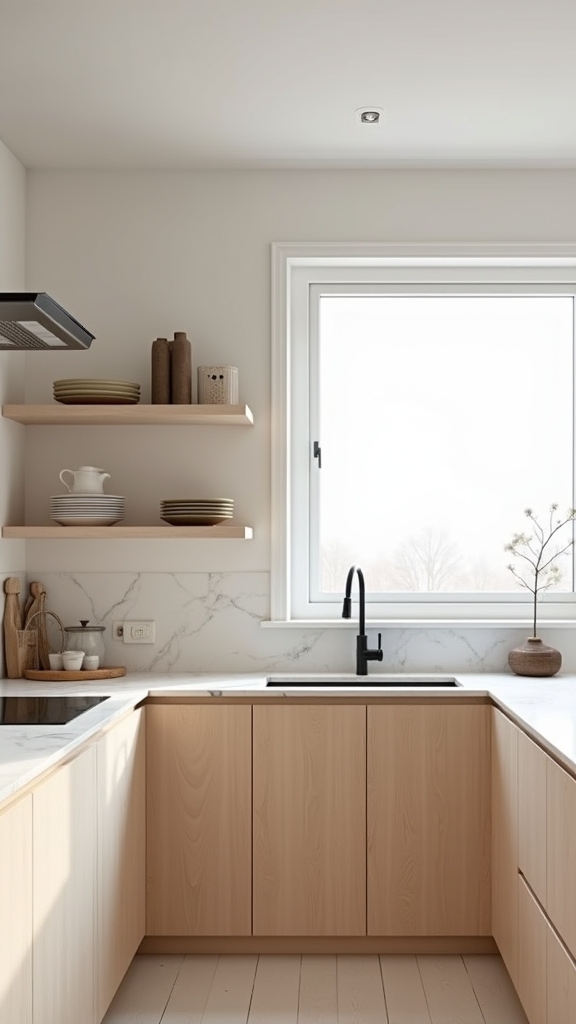
Although rooted in simplicity, Scandinavian-inspired minimalist design achieves a sophisticated balance between function and visual harmony through its use of flat-front white cabinetry and light beige countertops. This minimalist design ethos is further accentuated by matte white tiles, which maintain a sleek continuity while fostering warmth. The Scandinavian kitchen prioritizes abundant natural light, amplifying both the openness and the subtle undertones of warm beige. Functional analysis reveals that beige rugs and pendant lighting contribute not only to the visual cohesion but also to the tactile comfort, reinforcing the serene ambiance. The integration of natural materials and textures enhances the tranquil, organized atmosphere intrinsic to Scandinavian minimalism.
| Element | Functional Role |
|---|---|
| Flat-Front White Cabinetry | Streamlined storage, visual clarity |
| Light Beige Countertops | Warmth, contemporary foundation |
| Matte White Tiles | Sleekness, balanced light reflection |
Beige Pantry Doors for Subtle Contrast
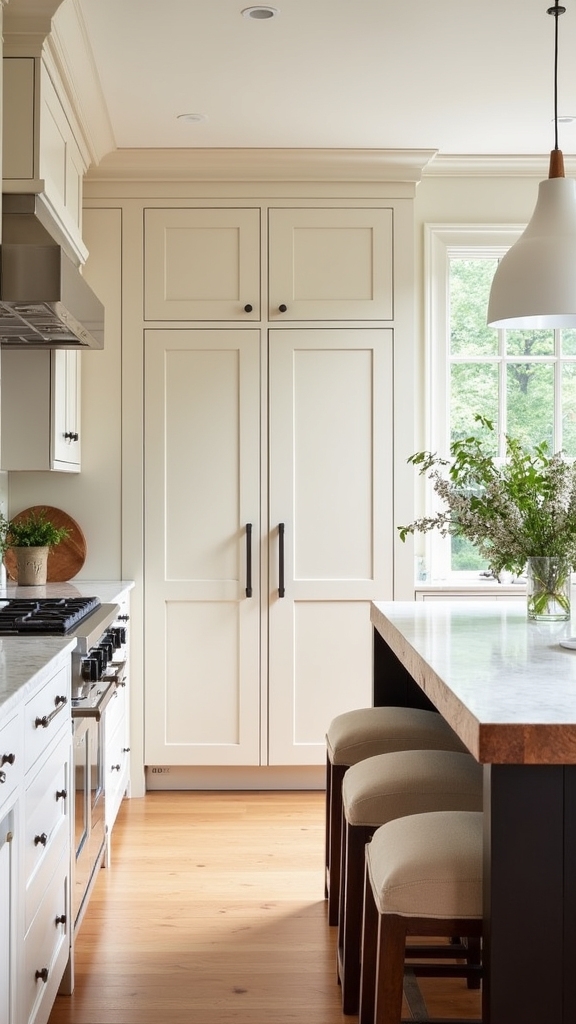
A strategic application of beige on pantry doors introduces understated contrast within a mainly white kitchen, elevating visual depth without disrupting the cohesive palette.
This nuanced interplay between beige cabinets and white surfaces creates a setting where warmth and visual interest are subtly accentuated. The functional and aesthetic advantages of this approach can be delineated as follows:
- Enhances architectural detailing on shaker cabinets, allowing the warm shade of beige to define paneling and molding.
- Provides a gentle shift between cabinetry and pantry, reinforcing a seamless yet distinct zone within the kitchen.
- Amplifies the perception of depth, making the space feel more dynamic without overwhelming minimalistic sensibilities.
- Increases decorative flexibility, as the neutral undertone of beige pantry doors coordinates effortlessly with evolving kitchen décor and accents.
Layered Natural Textures and Wood Finishes
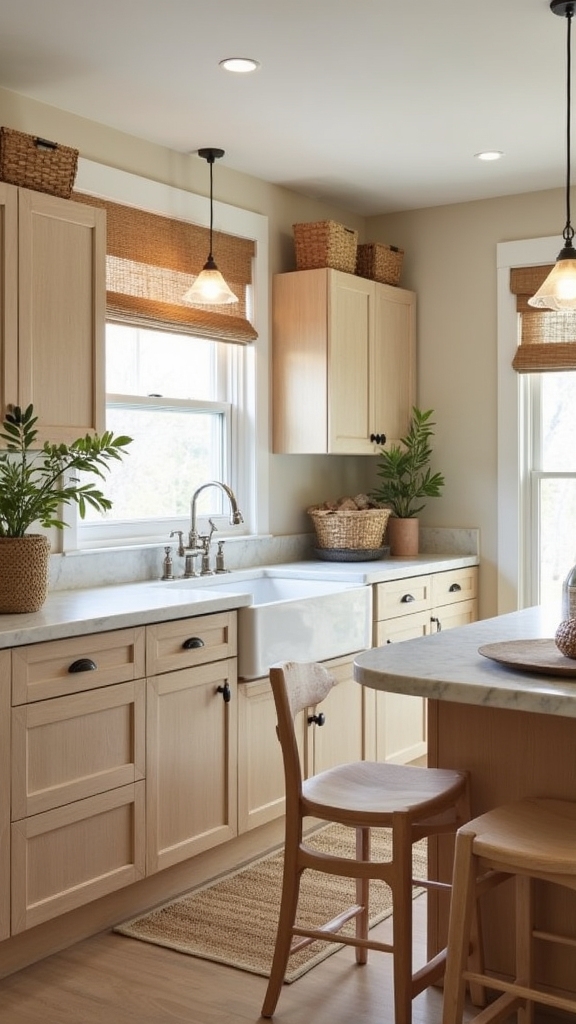
Building upon the nuanced contrasts introduced by beige pantry doors, the interplay of layered natural textures and wood finishes further enriches a beige and white kitchen’s visual narrative.
Integrating natural wood—such as light oak or walnut—infuses the space with warm wood undertones, creating a tactile balance between sleek white cabinetry and the soft, inviting appeal of a beige tone.
Layered textures, exemplified by a beige shiplap backsplash or butcher block countertops, introduce dimension and rustic sophistication, resonating with both modern and timeless sensibilities.
The addition of woven elements in bar stools or accents softens harder surfaces, contributing to an enveloping sense of comfort.
This strategic layering not only heightens visual interest but also enhances functionality, making the kitchen feel both cohesive and welcoming.
Incorporating shiplap ceilings can further elevate the kitchen’s aesthetic by adding a rustic farmhouse charm, which complements a warm and balanced design.
Black Hardware in a Creamy Setting
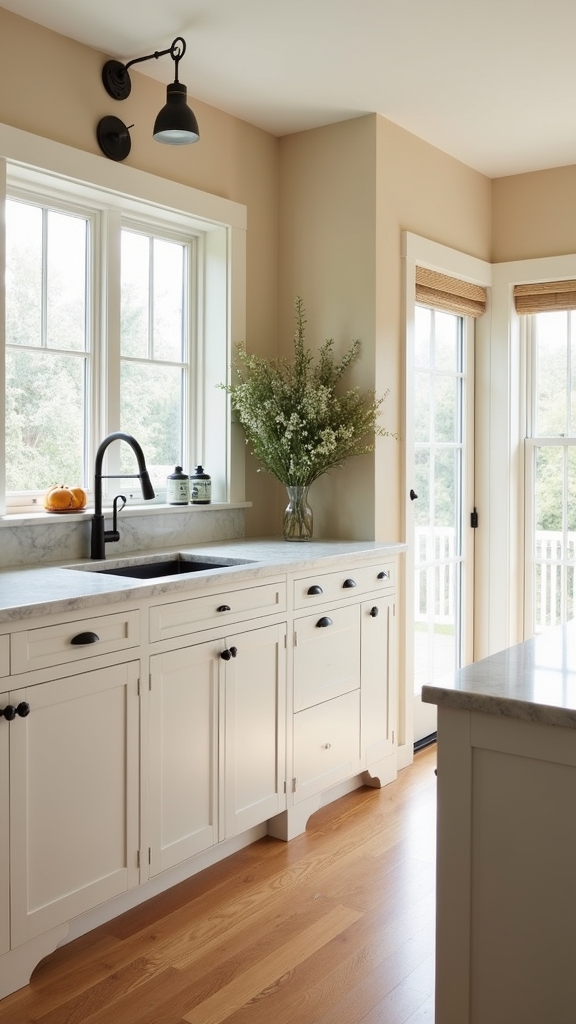
Introducing black hardware into a creamy kitchen palette establishes a deliberate visual contrast that sharpens the room’s architectural lines and infuses contemporary sophistication.
The juxtaposition of black accents against creamy cabinetry achieves a nuanced interplay of warm tones and crisp definition, resulting in increased visual interest and functional clarity.
Expert designers recognize the following advantages:
- Black handles and faucets ground the space, intensifying the warmth of beige and cream without overwhelming the palette.
- The contrast enhances the kitchen’s aesthetic, yielding a look that is simultaneously contemporary and timeless.
- Cohesion is achieved when black hardware is paired with other black elements, such as fixtures or appliances, creating a unified visual narrative.
- Strategically placed black details delineate functional zones, enhancing usability while preserving an inviting atmosphere.
Light Beige Open Shelving for Display

While black hardware sharpens and refines a creamy kitchen’s lines, light beige open shelving introduces an element of warmth and visual openness.
Strategically positioned within a beige and white kitchen, these shelves serve as a transitional element, softening stark contrasts and enhancing spatial perception.
Light beige open shelving seamlessly integrates with white cabinetry, establishing a cohesive aesthetic and reinforcing modern minimalism.
Light beige open shelving blends effortlessly with white cabinetry, creating a unified modern look that embodies minimalist elegance.
Functionally, these shelves invite curated displays—dishware, ceramics, or textured accents—allowing homeowners to add warmth and personalized character without clutter.
The soft hue of light beige acts as a versatile canvas, complementing both contemporary and rustic motifs.
Beige Brick or Shiplap Feature Wall
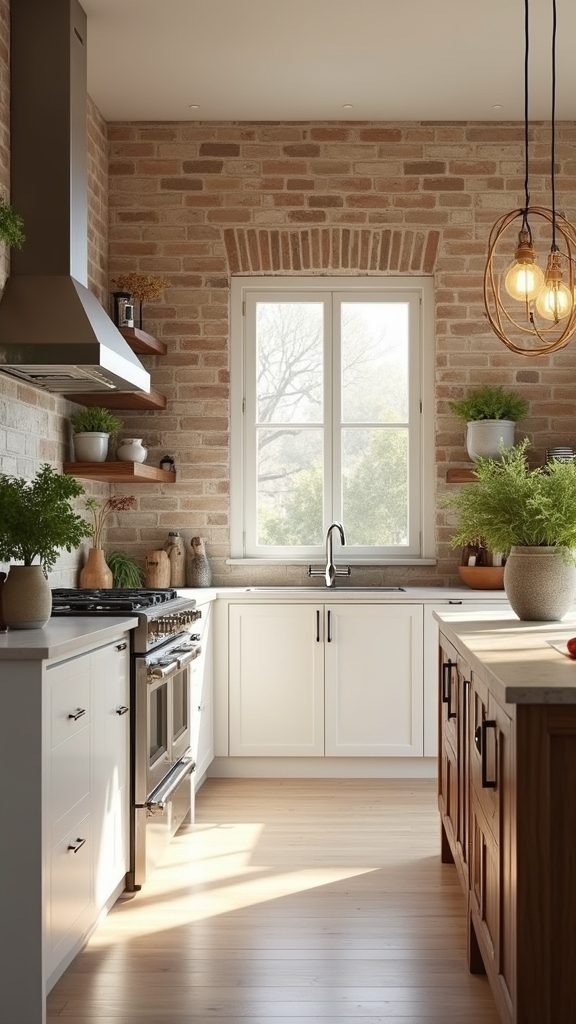
A beige brick or shiplap feature wall introduces tactile richness and visual depth, contrasting effectively with crisp white cabinetry for a balanced palette.
This interplay of warm neutrals and clean whites provides a versatile foundation, enabling seamless integration of natural accents such as wood, rattan, or greenery.
Functionally, the feature wall serves as both a focal point and an atmospheric enhancer, fostering a welcoming environment within the kitchen space.
Textural Warmth and Depth
By integrating a beige brick or shiplap feature wall, the kitchen space attains a nuanced interplay of texture and warmth that enhances its visual and tactile appeal.
These textural elements, whether manifested as beige brick or refined shiplap paneling, serve as pivotal design interventions that uplift both the sensory and aesthetic experience. Their presence accomplishes several functional objectives:
- Establishes a warm backdrop that grounds the kitchen’s atmosphere and introduces rustic or modern undertones.
- Amplifies textural depth through tactile surfaces, inviting visual movement and raising spatial interest.
- Harmonizes with white cabinetry, facilitating a balanced convergence of traditional and contemporary styles.
- Acts as a focal point, drawing attention and providing an ideal canvas for curated decorative accents.
This approach underscores how materiality shapes ambiance and function.
Complementary Color Pairings
Several sophisticated color strategies can enhance the impact of a beige brick or shiplap feature wall within a mainly white kitchen.
The juxtaposition of beige walls with crisp white cabinetry establishes a visually compelling contrast while maintaining a cohesive palette. This pairing supports a cozy atmosphere by introducing warmth and subtle depth, counterbalancing the cool undertones of white surfaces.
Beige brick, rich in texture, infuses the space with rustic character, particularly effective in farmhouse-inspired designs. Alternatively, light beige shiplap maximizes natural light reflection, promoting an open and airy ambiance.
Functionally, these feature walls define spatial zones without diminishing the kitchen’s sense of openness. The enduring combination of beige and white cabinetry guarantees a timeless appeal, making the kitchen inviting and perpetually relevant.
Styling With Natural Accents
When natural accents such as beige brick or shiplap feature walls are introduced into a primarily white kitchen, they anchor the design with tactile warmth and visual depth.
The strategic incorporation of these natural materials serves several expert design functions:
- Beige brick infuses rustic charm and coziness, counterbalancing the sleek minimalism of white cabinetry.
- Shiplap walls in soft beige enhance texture and complement white surfaces, fostering an inviting ambiance.
- These materials establish a harmonious connection between interior and exterior spaces, promoting biophilic design principles.
- Utilizing beige brick or shiplap as a focal point provides a visually engaging backdrop, supporting personal décor elements while maintaining cohesion.
Collectively, these techniques result in a balanced, welcoming kitchen environment, rich in character and architectural interest.
Soft Herringbone Patterns in Flooring
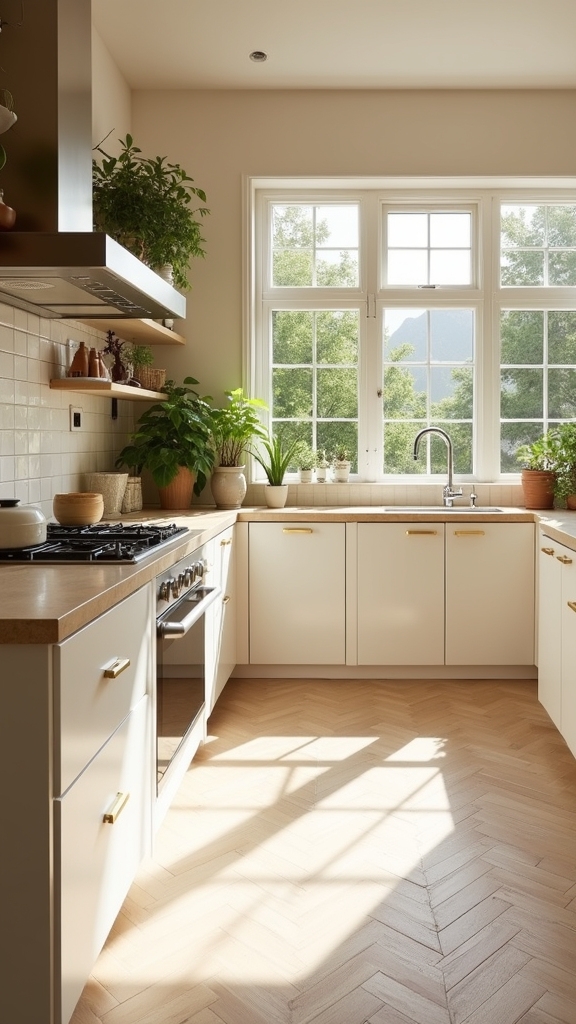
Soft herringbone patterns in kitchen flooring introduce a refined geometric motif that enhances both the visual and tactile experience of beige and white interiors. This pattern delivers visual interest by breaking up expanses of neutral tones with dynamic yet subtle movement, lending warmth and sophistication.
In beige and white kitchens, the interlocking arrangement of planks or tiles unifies the palette, ensuring cohesion while providing a nuanced textural layer. Materials such as wood or ceramic tile offer flexibility, enabling adaptation to modern or traditional aesthetics.
The directional flow of soft herringbone patterns can elongate the perceived dimensions of compact spaces, maximizing spatial perception. Ultimately, this design imparts a timeless quality, elevating kitchens with a motif that balances enduring elegance and functional appeal.
Mixed Beige and White Marble Surfaces
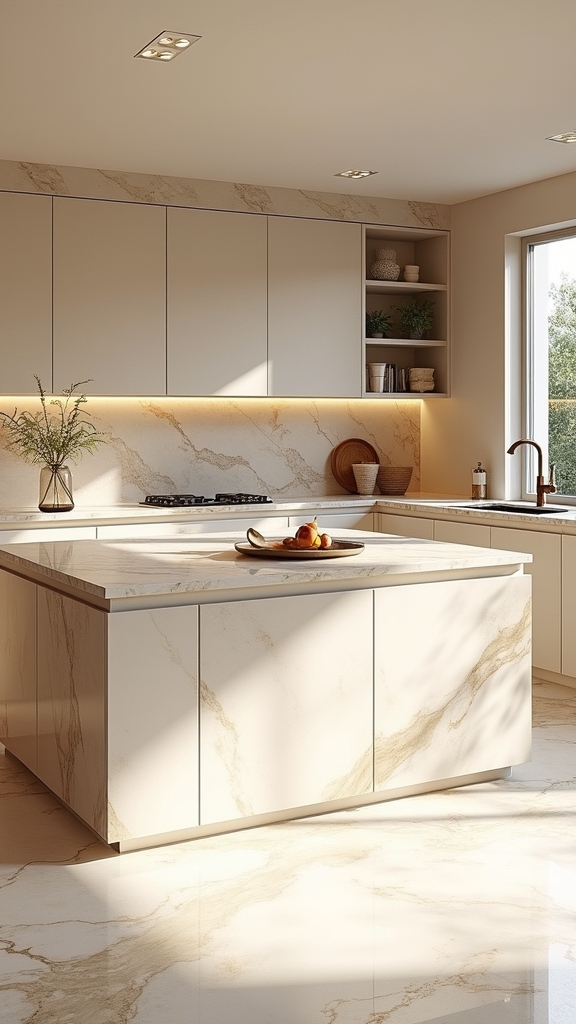
Marble, distinguished by its organic veining and nuanced color gradations, offers a sophisticated foundation for beige and white kitchen designs.
Mixed beige and white marble surfaces are highly sought for their ability to merge classic warmth with contemporary clarity. This material selection provides a warm and inviting feel while maintaining a refined visual impact.
Expert analysis highlights the following key advantages:
- Mixed marble surfaces introduce harmonious contrast, amplifying depth and visual interest within the kitchen.
- The interplay of beige and white tones brightens the space, enhancing both light reflection and ambient warmth.
- Versatility in complementing cabinetry makes these surfaces adaptable to both modern and traditional styles.
- Beyond aesthetics, marble is durable and easy to clean, fitting high-traffic kitchen environments with practical longevity.
Each installation offers a unique, signature look.
Cozy Breakfast Nook in Neutral Tones
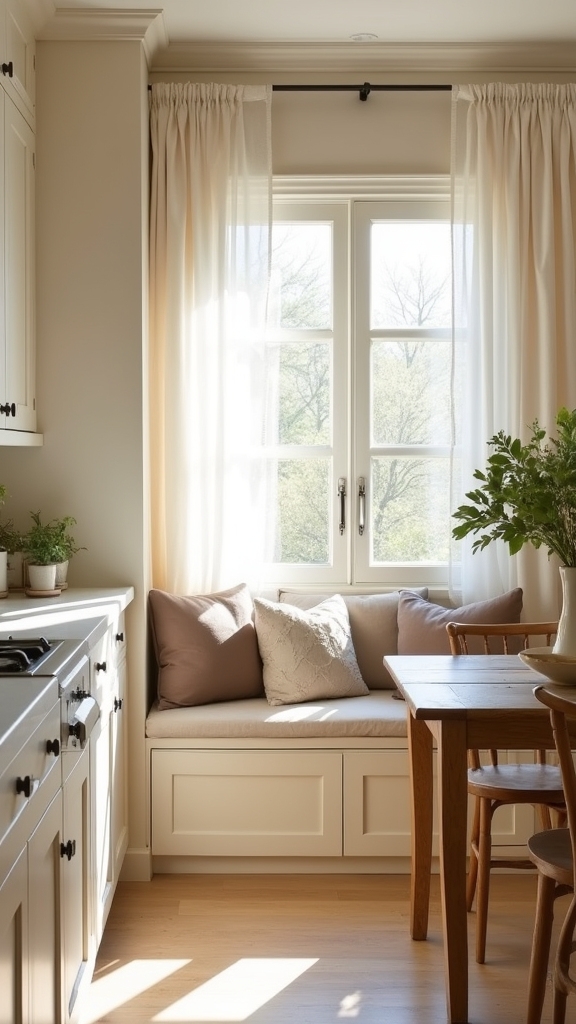
Although minimalist in palette, a cozy breakfast nook in neutral tones leverages the interplay between beige and white to establish a tranquil, inviting environment within the kitchen.
The use of soft beige cushions paired with a natural wooden table introduces tactile comfort and visual cohesion, accentuating the warmth inherent in a beige and white scheme.
Large windows maximize natural lighting, infusing the nook with an airy, spacious quality while highlighting subtle color nuances.
Decorative accents, such as beige ceramics or white dishware on open shelving, impart character and personalize the serene space.
Strategic lighting solutions—pendant lights or sconces with warm metallic finishes—further augment the cozy ambiance.
This careful orchestration of materials, lighting, and color guarantees the breakfast nook functions as a harmonious retreat.
Modern Appliances in a Classic Palette
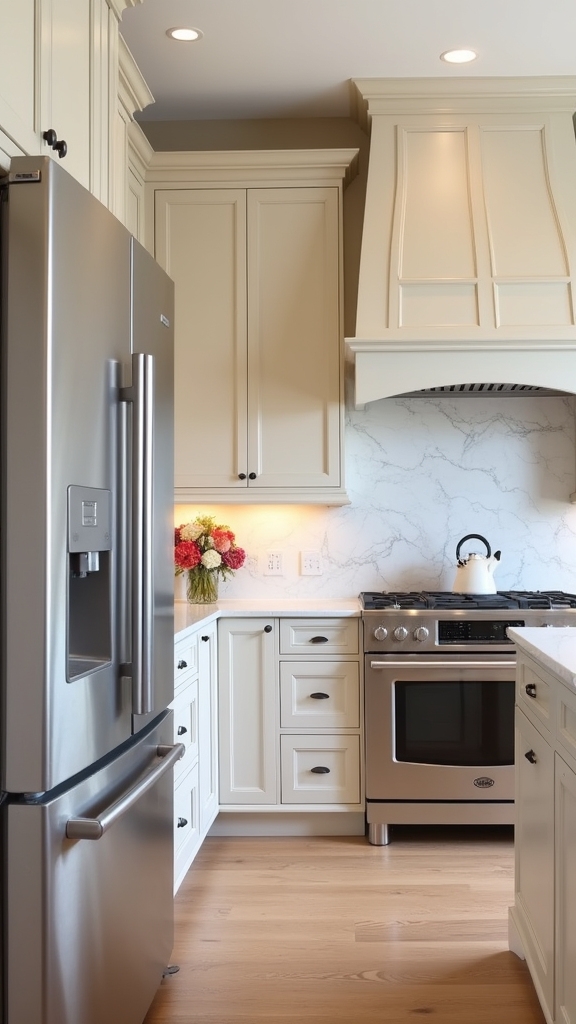
Stainless steel appliances introduce a refined, high-contrast element within beige and white kitchens, amplifying both visual interest and functional sophistication.
The integration of smart technology into neutral-toned spaces supports streamlined workflows and enhances user experience without disrupting the classic palette.
This synthesis of advanced features and timeless tones results in a kitchen environment that is both efficient and visually harmonious.
Integrating Stainless Steel Elegance
When integrated within a beige and white kitchen, modern stainless steel appliances establish a striking visual interplay between classic warmth and contemporary innovation.
The juxtaposition of stainless steel against beige cabinetry introduces a modern vibe while preserving the inviting qualities of a traditional palette. This combination enhances the space both aesthetically and functionally.
Key advantages include:
- Reflective Surfaces: Stainless steel’s sheen amplifies natural and artificial light, enhancing spatial openness within the neutral scheme.
- Seamless Contrast: The sleek metallic finish contrasts yet harmonizes with beige cabinetry, providing a balanced, sophisticated focal point.
- Functional Sophistication: Modern appliances deliver cutting-edge performance, marrying utility with refined elegance.
- Effortless Maintenance: Fingerprints and smudges are less conspicuous on neutral cabinetry, supporting easy upkeep and enduring appeal.
Smart Tech in Neutral Spaces
How does advanced technology integrate seamlessly into the enduring appeal of beige and white kitchens? The answer lies in the strategic deployment of smart appliances within neutral spaces, where form and function coalesce.
Smart ovens, refrigerators, and touchless faucets are engineered with sleek, minimalist interfaces that visually harmonize with the modern beige palette, maintaining uncluttered lines and subtle sophistication.
Integrated smart lighting systems further enhance usability, creating adaptable ambiances while preserving the warm, inviting atmosphere central to neutral kitchens.
Energy-efficient smart appliances not only fulfill aesthetic expectations but also promote eco-conscious living—a value increasingly significant in contemporary kitchen design.
Concealing built-in smart home systems within custom cabinetry guarantees cutting-edge technology remains unobtrusive, reinforcing the timeless balance of functionality and visual tranquility in beige and white spaces.
Integrated Lighting for a Warm Glow
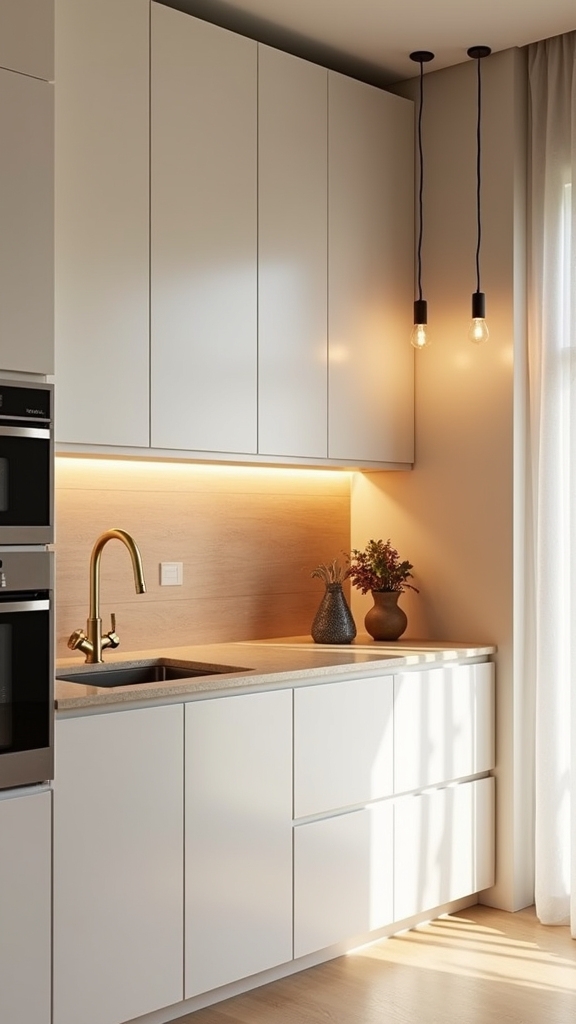
By strategically incorporating integrated lighting—such as under-cabinet strips and recessed ceiling fixtures—a beige and white kitchen’s design achieves both visual warmth and operational efficiency.
Integrated lighting accentuates the warm tones of beige cabinetry, establishing a cozy atmosphere without overpowering the neutral palette. Expertly designed layered lighting solutions address both functional needs and aesthetic aspirations.
Consider the following approach:
- Under-cabinet LED strips highlight countertops, providing shadow-free illumination for precision-oriented tasks.
- Recessed ceiling fixtures deliver unobtrusive general lighting, ensuring consistent ambient brightness throughout the kitchen.
- Pendant lights above a beige island serve as sculptural focal points, introducing depth while reinforcing warm tones.
- Dimmable controls enable seamless shifts from task-focused brilliance to intimate, subdued glows, tailoring the atmosphere for every occasion.
This integration enhances both functionality and ambiance.
Frequently Asked Questions
What Color Goes With Beige in the Kitchen?
When selecting beige accent colors for kitchens, designers recommend pairing warm beige tones with soft greys or crisp whites. Contrasting beige cabinetry with black or metallic fixtures, and exploring beige backsplash ideas, enhances visual depth and functional elegance.
How to Make an All White Kitchen Feel Warm?
To infuse warmth into an all-white kitchen, designers recommend integrating layered kitchen textures, utilizing warm lighting solutions, selecting strategic decorative accents, and introducing natural elements. These components enhance visual interest and foster a more inviting, balanced environment.
How to Jazz up a Beige Kitchen?
To enhance beige kitchen decor, one might introduce beige accent walls for tonal layering, select warm beige tones in cabinetry, and incorporate metallic beige kitchen accessories. This approach improves visual interest, depth, and functional cohesion within the space.
Do Cream and White Go Together in a Kitchen?
Pairing cream undertones with white in a kitchen achieves color harmony and design balance. Strategic kitchen accents, such as wood or metallic finishes, visually emphasize depth and warmth, resulting in a timeless, functionally cohesive aesthetic.
Conclusion
These fifteen beige and white kitchen concepts expertly balance visual warmth with functional clarity. Through strategic use of tone—ranging from creamy Shaker cabinets to off-white backsplashes—each design leverages color theory to enhance spatial perception and light diffusion. Brass accents and layered marble introduce subtle visual interest, while integrated lighting guarantees a welcoming ambiance. Collectively, these kitchens embody an intersection of timeless aesthetics and ergonomic practicality, demonstrating how neutral palettes can create spaces that are both inviting and highly functional.
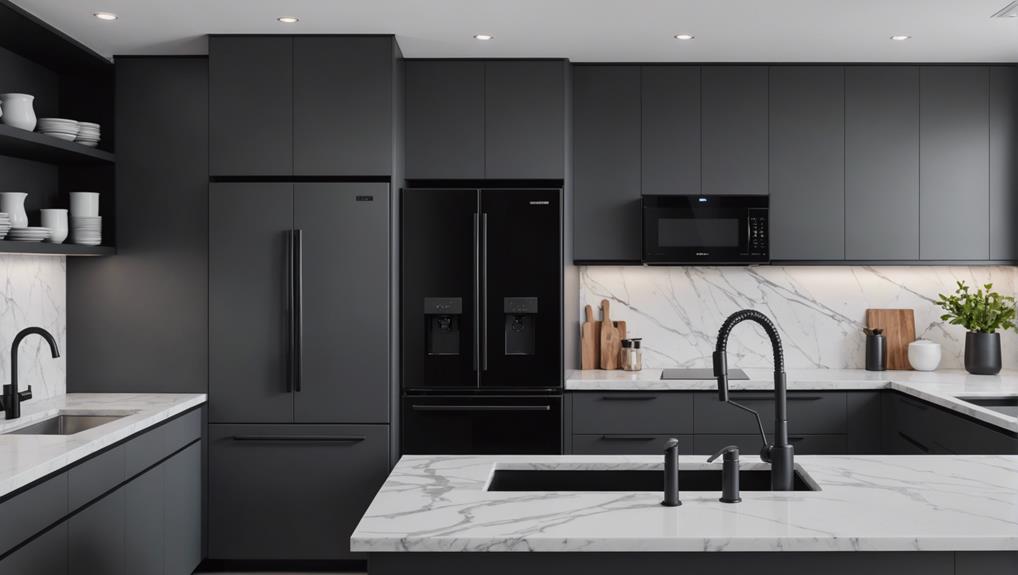
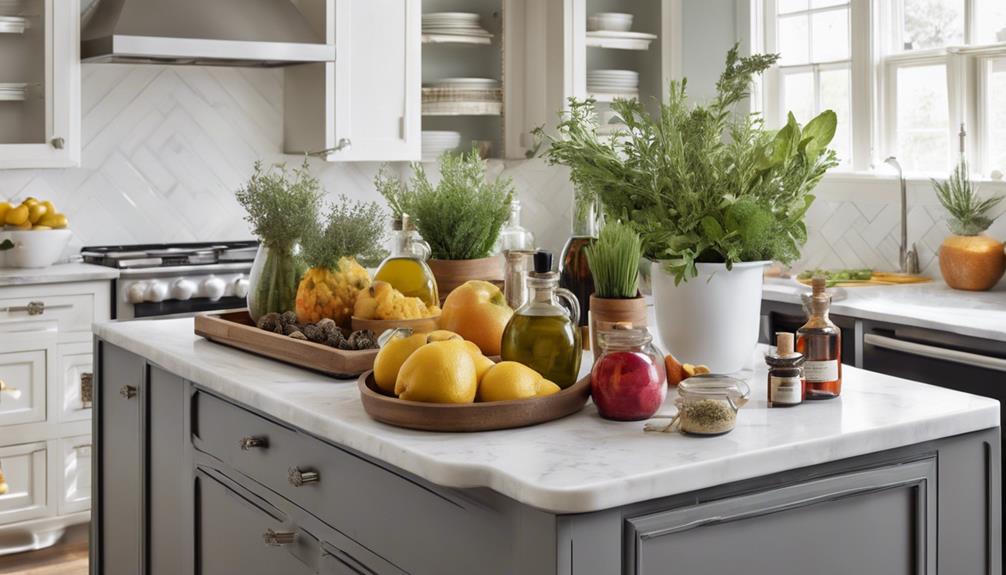
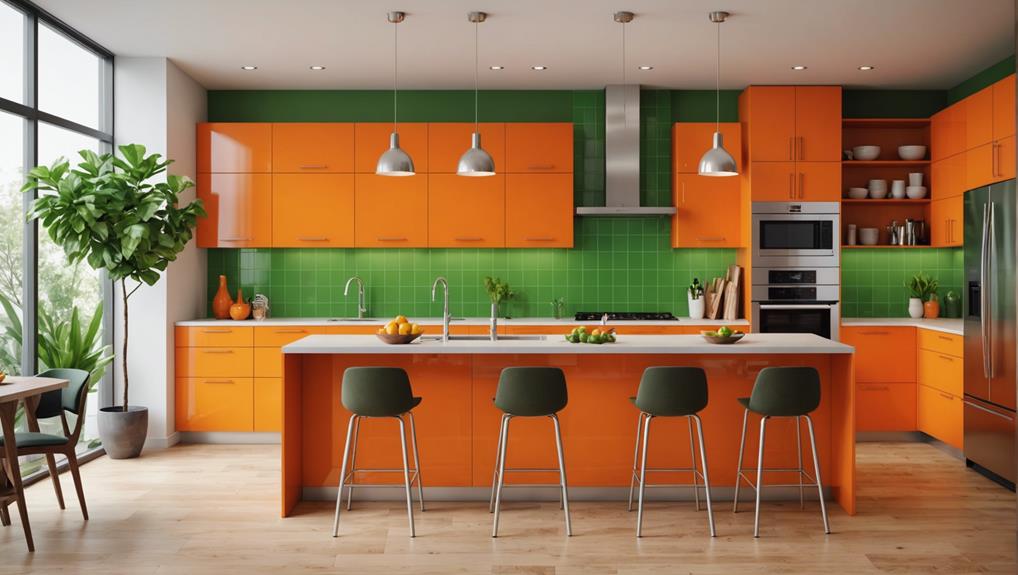
Leave a Reply